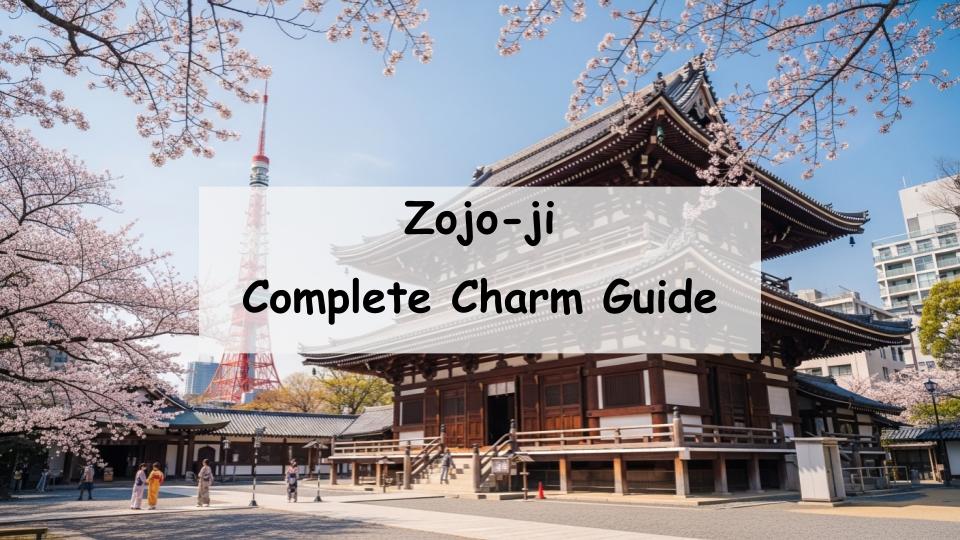“What kind of temple is Zojoji? Where is it located, and what makes it worth visiting?”
If you’ve asked yourself these questions, you’re not alone.
In short, Zojoji is a historic temple closely associated with the Tokugawa shogunate, known for its grand architecture set against Tokyo Tower, the burial site of shoguns, and its seasonal beauty throughout the year.
This article offers a comprehensive introduction to Zojoji Temple, including its history, cultural significance, must-see spots, and detailed access information. Whether you’re a first-time visitor or a seasoned Tokyo explorer, read on to discover why Zojoji deserves a place on your itinerary.
What is Zojoji? History and Overview
Origins and Historical Background
Zojoji Temple is a head temple of the Jodo (Pure Land) sect of Buddhism, founded in 1393 by the monk Saint Sosu. During the Edo period, it became the family temple of the Tokugawa clan, elevating its status significantly. It also held importance as a feng shui guardian of Edo Castle’s rear demonic gate.
Connection to the Tokugawa Shoguns and Their Mausoleums
Zojoji is notable for being the resting place of six Tokugawa shoguns, including the second shogun, Tokugawa Hidetada. Though much of the original mausoleum complex was lost to wartime fires, parts have been restored and remain accessible to visitors.
The Temple’s Current Role and Affiliation
Today, Zojoji continues to function as a center of Jodo Buddhism, hosting religious events and ceremonies. Its location in central Tokyo also makes it a popular tourist attraction visited by both locals and international travelers.
Must-See Highlights at Zojoji Temple
The Grand Main Hall and Its Imposing Architecture
The Main Hall (Daiden) of Zojoji is a stunning wooden structure that blends traditional and modern design. With Tokyo Tower looming behind it, the hall offers one of the most iconic photo spots in the city.
Historical Value of the Tokugawa Mausoleums
Once rivaling Nikko Toshogu Shrine in grandeur, Zojoji’s Tokugawa mausoleums symbolize the clan’s prestige. Though not all have survived, the restored sections allow visitors to reflect on their historical significance.
Breathtaking View with Tokyo Tower
The view of Tokyo Tower rising behind the temple’s traditional buildings creates a unique contrast between old and new Japan. In the evening, the lit-up tower adds a magical touch to the temple’s serene atmosphere.
Seasonal Landscapes (Cherry Blossoms, Autumn Leaves, Snow)
Spring: Cherry Blossoms Framing the Main Hall
In spring, the temple grounds are adorned with cherry blossoms, contrasting beautifully with the dark roof of the main hall, attracting photographers and hanami (flower viewing) enthusiasts.
Autumn: Vivid Leaves Complementing Buddhist Architecture
The fall foliage turns the temple into a canvas of reds and golds, accentuating the temple’s wooden structures and creating postcard-worthy scenery.
Cultural Significance and Spiritual Role
Buddhist Statues and Temple Treasures
The central statue of Amida Nyorai in the main hall is serene and majestic. Zojoji also houses various important Buddhist images, artifacts, and historical scrolls.
Annual Events and Memorial Ceremonies
The temple hosts major events throughout the year, such as New Year’s visits, Obon, equinox ceremonies, and Setsubun. Many are open to the public, offering a deep insight into Japanese Buddhist customs.
Community Engagement and Social Role
Zojoji is deeply involved in the local community, serving as an evacuation site in times of disaster and organizing lectures, children’s events, and cultural programs.
How to Get to Zojoji Temple
By Train and Bus
The temple is just a 3-minute walk from Onarimon Station (Toei Mita Line), and about 5 minutes from Daimon Station (Toei Asakusa & Oedo Lines). It’s also within walking distance of JR Hamamatsucho Station.
By Car and Parking Info
While the temple’s own parking is limited, many paid parking lots are available nearby. It’s best to avoid peak hours to ensure smooth access.
Recommended Nearby Sightseeing Spots
Zojoji’s location makes it easy to combine with nearby attractions like Tokyo Tower, Shiba Park, and Hamarikyu Gardens, offering a full day of sightseeing in central Tokyo.
Tips for Visiting Zojoji Temple
Visiting Hours, Admission, and Time Needed
Admission to the main hall is free. Visiting hours are typically from 6:00 AM to 5:00 PM. A relaxed visit, including the mausoleum, takes about 1 to 1.5 hours.
Best Times to Avoid Crowds
Zojoji can be crowded during New Year’s and cherry blossom season. Weekday mornings are ideal for a peaceful visit and great lighting for photography.
Cafes, Shops, and Local Food
The temple grounds include small tea houses and shops. Nearby Hamamatsucho and Daimon areas offer plenty of options for Japanese cuisine and cozy cafes.
Trivia and Tips for Enjoying More
Legends and Tales About Zojoji
Numerous stories link Zojoji to the Tokugawa family’s legacy, including grand funeral processions and mythical objects passed down through generations.
Featured in Films and Dramas
The temple’s photogenic scenery has appeared in many films and TV dramas, highlighting its unique mix of tradition and modern urban background.
Events and Photo Spots for Every Season
From cherry blossom festivals to summer bon dances, autumn foliage, and winter snowscapes, Zojoji offers year-round photo opportunities and seasonal charm.
Conclusion: Experience Tokyo’s History at Zojoji Temple
Recap of Zojoji’s Appeal
Zojoji is a rare site where deep history, religious significance, architectural beauty, and modern Tokyo coexist. A visit here offers a truly unique cultural experience.
Suggested Itinerary for First-Time Visitors
Start your morning with a serene walk through Zojoji and its mausoleum. Head to Tokyo Tower or Shiba Park afterward, then enjoy lunch at a nearby restaurant. It’s a perfect introduction to Tokyo’s blend of old and new.







Comment